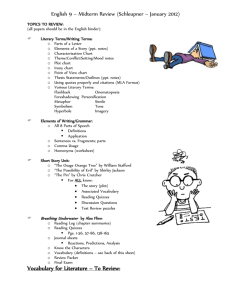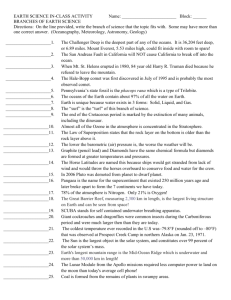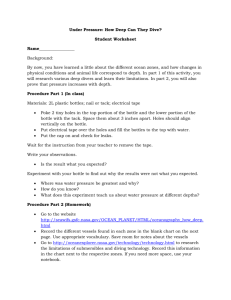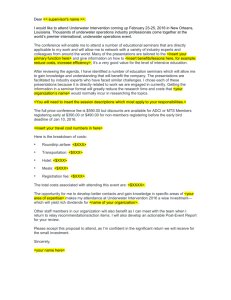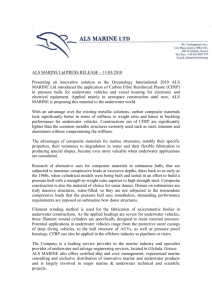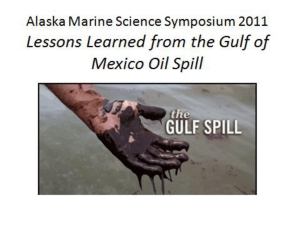REU_CAS_2012 - Underwater Sensor Network Lab
advertisement
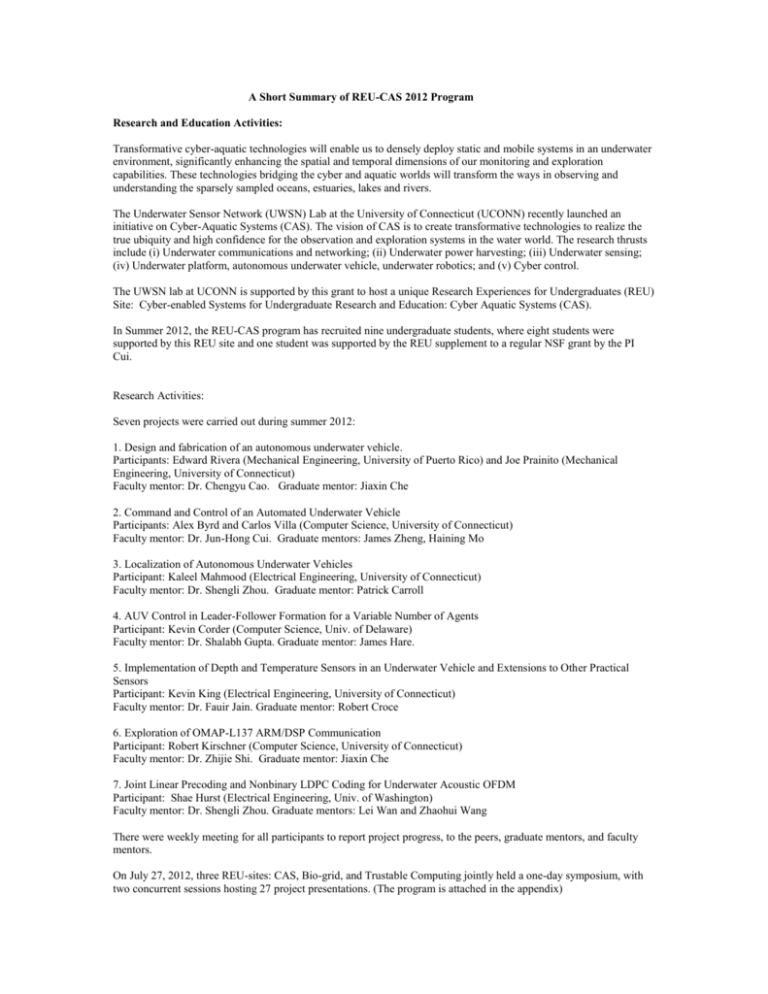
A Short Summary of REU-CAS 2012 Program Research and Education Activities: Transformative cyber-aquatic technologies will enable us to densely deploy static and mobile systems in an underwater environment, significantly enhancing the spatial and temporal dimensions of our monitoring and exploration capabilities. These technologies bridging the cyber and aquatic worlds will transform the ways in observing and understanding the sparsely sampled oceans, estuaries, lakes and rivers. The Underwater Sensor Network (UWSN) Lab at the University of Connecticut (UCONN) recently launched an initiative on Cyber-Aquatic Systems (CAS). The vision of CAS is to create transformative technologies to realize the true ubiquity and high confidence for the observation and exploration systems in the water world. The research thrusts include (i) Underwater communications and networking; (ii) Underwater power harvesting; (iii) Underwater sensing; (iv) Underwater platform, autonomous underwater vehicle, underwater robotics; and (v) Cyber control. The UWSN lab at UCONN is supported by this grant to host a unique Research Experiences for Undergraduates (REU) Site: Cyber-enabled Systems for Undergraduate Research and Education: Cyber Aquatic Systems (CAS). In Summer 2012, the REU-CAS program has recruited nine undergraduate students, where eight students were supported by this REU site and one student was supported by the REU supplement to a regular NSF grant by the PI Cui. Research Activities: Seven projects were carried out during summer 2012: 1. Design and fabrication of an autonomous underwater vehicle. Participants: Edward Rivera (Mechanical Engineering, University of Puerto Rico) and Joe Prainito (Mechanical Engineering, University of Connecticut) Faculty mentor: Dr. Chengyu Cao. Graduate mentor: Jiaxin Che 2. Command and Control of an Automated Underwater Vehicle Participants: Alex Byrd and Carlos Villa (Computer Science, University of Connecticut) Faculty mentor: Dr. Jun-Hong Cui. Graduate mentors: James Zheng, Haining Mo 3. Localization of Autonomous Underwater Vehicles Participant: Kaleel Mahmood (Electrical Engineering, University of Connecticut) Faculty mentor: Dr. Shengli Zhou. Graduate mentor: Patrick Carroll 4. AUV Control in Leader-Follower Formation for a Variable Number of Agents Participant: Kevin Corder (Computer Science, Univ. of Delaware) Faculty mentor: Dr. Shalabh Gupta. Graduate mentor: James Hare. 5. Implementation of Depth and Temperature Sensors in an Underwater Vehicle and Extensions to Other Practical Sensors Participant: Kevin King (Electrical Engineering, University of Connecticut) Faculty mentor: Dr. Fauir Jain. Graduate mentor: Robert Croce 6. Exploration of OMAP-L137 ARM/DSP Communication Participant: Robert Kirschner (Computer Science, University of Connecticut) Faculty mentor: Dr. Zhijie Shi. Graduate mentor: Jiaxin Che 7. Joint Linear Precoding and Nonbinary LDPC Coding for Underwater Acoustic OFDM Participant: Shae Hurst (Electrical Engineering, Univ. of Washington) Faculty mentor: Dr. Shengli Zhou. Graduate mentors: Lei Wan and Zhaohui Wang There were weekly meeting for all participants to report project progress, to the peers, graduate mentors, and faculty mentors. On July 27, 2012, three REU-sites: CAS, Bio-grid, and Trustable Computing jointly held a one-day symposium, with two concurrent sessions hosting 27 project presentations. (The program is attached in the appendix) Social activities: The REU-CAS program has included the following other activities: -- A welcome Pizza party was held at May 21, 2012, 6pm, at ITE building, Room 301. This event was jointly held with other two REU sites at UCONN: Bio-grid and Trustable Computing. After the pizza party, the REU-CAS students had a tour to the USWN lab. -- An engineering ethics seminar was held at 9am, June 7th, at UTEB 150. The speaker was Dr. Dan Vallero from Duke University. -- Two technical research writing workshops were provided by Prof. John Chandy, one on presentation skills and the other on technical research writing of technical reports. -- A field trip was done at June 19, 2012, to visit the Avery Point Campus of UCONN. This visit includes the following components (a) 1:30 pm-2:30 pm. Lab tour to the Department of Marine Science and the Northeast Underwater Research Technology and Education Center (NURTEC); (b) 3:00 pm – 4:00 pm. Attend a panel Discussion: “Long Island Sound - Economic, Recreational” held by Innovation Connection. (c) 4 pm -6 pm. Attend the “Welcome to Avery Point” campus tour. Findings: Seven research projects have been successfully carried out. 1. Design and fabrication of an autonomous underwater vehicle; (by Edward Rivera and Joe Prainito) In this project, the process of designing and manufacturing of a cost-efficient Autonomous Underwater Vehicle (AUV) is presented. The AUV is constructed as a carrier for demonstrating the capabilities of the Orthogonal Frequency Division Multiplexing (OFDM) modem developed for underwater acoustic communication. Four main phases are developed in order to complete the project goals: the designing of a chassis, the method of thrust generation, the method of buoyancy control, and the testing and implementation phase. In order to accomplish these phases, hydrostatic and hydrodynamic theories were considered during this project. Based on these principles and the implementation of the OFDM modem, the Gumstix, the Inertial Measurement Unit (IMU) and the Microcontroller Unit (MCU), the vehicle is capable of stabilizing itself without requiring any pilot input and to follow a designated path while collecting and wireless transmitting data. 2. Command and Control of an Automated Underwater Vehicle; (by Alex Byrd and Carlos Villa) Unmanned underwater vehicles (UUVs) have become commonplace in underwater research and in military applications due to recent technological advances. We have achieved command and control of a custom built unmanned underwater vehicle using a Gumstix Overo COM, a 32-bit ARM device microcontroller, and a 9DOF Razor inertial measurement unit. Communication with the UUV is maintained from an onshore monitoring station via an Orthogonal Frequency Division Multiplexing acoustic modem. We have implemented algorithms to process movement commands from the monitoring station, retrieve and display sensor data, and stabilize the AUV along its current path. These algorithms were developed in the C programming language for the Linux environment of the Gumstix COM. We have also implemented a Graphical User Interface that displays sensor and localization data from an arbitrary number of UUVs and gives the user the ability to directly control each UUV. The GUI was implemented in the Java-based Processing language. 3. Localization of Autonomous Underwater Vehicles; (by Kaleel Mahmood) Autonomous underwater vehicles (AUV) have applications in aquatic exploration and research. AUVs require tracking so they can traverse underwater environments and record the location of where data samples are taken. We tested underwater communication through acoustic signals and implemented localization using two algorithms, least squares and maximum likelihood. Communication infrastructure was designed around these algorithms in the form of four anchor nodes to send signals and one acoustic modem to receive and process the signals to compute location. Real times testing of the localization algorithms were conducted in University of Connecticut swimming pool. Results showed that the maximum likelihood could be feasibly implemented and produced a position within 2 meters of the actual AUV position. 4. AUV Control in Leader-Follower Formation for a Variable Number of Agents; (by Kevin Corder) Autonomous Underwater Vehicles are used in many real world applications, such as mapping an unexplored sea floor or searching for underwater mines. There are many documented algorithms for AUV movement, but few for leaderfollower formation which is a highly valuable type for searching in large scale testing. The algorithms we show here are written using only knowledge of position, meaning no optics or sonar on the vehicle. The algorithms were also designed to overcome a propagation delay of information updating due to the means for underwater localization, and written generally for any number of AUVs. We created a new, intuitively designed, efficient program for moving a fleet of AUVs to specified points in a leader-follower formation, while avoiding collision with each other and with given boundaries. Hopefully with more efficient algorithms and applications, we may someday reach a point where deploying a team of unmanned vehicles is no longer a challenge. 5. Implementation of Depth and Temperature Sensors in an Underwater Vehicle and Extensions to Other Practical Sensors; (by Kevin King) Data collection is a vital part of underwater exploration, and most of today’s data collection processes are in the form of sensors. A series of experiments was carried out to test the effectiveness of commercial grade, field-deployable sensors in an underwater vehicle. Two sensors were implemented: one that measures depth, and another that measures temperature. Both were calibrated in realistic tests, and both gave accurate results. Each uses an amplified output, meaning that it sends a current through a resistive circuit, where the current is linearly proportional to the data that it is collecting (the minimum is 4mA and the maximum is 20mA). This current was sent through a 100Ω resistor, and the voltage across that resistor was converted into a digital reading using an ADC. The implementation of the sensors in this project is simple, and therefore has other, more practical applications in the field of environmental monitoring. Because of this, a possible design scheme for a nitrate sensor is also given, along with potential roadblocks in implementing such a sensor. 6. Exploration of OMAP-L137 ARM/DSP Communication; (Robert Kirschner) This research project explores the communication protocols between the DSP and ARM processors in a Texas Instruments (TI) OMAP-L137 processor, and uses these to establish abstract software libraries for other researchers to utilize said protocols without detailed knowledge of their inner mechanisms. These libraries will allow the acoustic modem used by the Cyber Aqua Systems REU to be ported to the OMAP-L137 platform, which should offer improvements in efficiency, especially with regard to its intended use with Autonomous Underwater Vehicles (UAVs). This project was able to deliver a working processor communication library, implementing the same interface used with the modem’s current hardware. In addition to this, this project has explored some of the efficiency increases the OMAPL137 platform offers over the current hardware implementation. 7. Joint Linear Precoding and Nonbinary LDPC Coding for Underwater Acoustic OFDM; (by Shae Hurst) Underwater communication channels suffer from fading and noise, so to improve performance joint linear precoding was combined with nonbinary LDPC coding. Without increasing complexity precoding results in higher performance, which is greatly needed in adverse underwater conditions. Computer simulation results have shown a substantial improvement, when precoding is performed on channels with Rayleigh fading, while channels with only AWGN are not improved by precoding. The addition of multiple receivers was also studied, and it was found that increasing the number of receivers did improve the performance, but that this improvement between precoded and uncoded channels decreased with the number of receivers added. Therefore, by only applying slight changes on the transmitter and receiver ends, performance could be increased in fading underwater channels without increasing complexity. Summary The seven projects were carefully designed, which allowed the participants in different projects in three different departments (Mechanical, Electrical, and Computer science) can interact with each other under the same umbrella of cyber-aquatic systems. Multiple projects needed to perform experiments in swimming pools, where the students had been well coordinated. These projects have led to four conference paper publications. Four presentations have been made in the IEEE/MTS Oceans Conference, Hampton Roads, Oct. 2012. Training and Development: Outreach Activities: Two local high students, Samuel Li and Alice Hu, have participated in the construction of autonomous vehicle constructions, and testings in the swimming pool. They have also attended in a good portion of the weekly meetings. Figure 1: The group picture of the participating undergraduate students and faculty mentors, taken at the symposium. Figure 2: A joint demonstration in a swimming pool illustrates the close relationships of the seven projects involved Figure 3: The architecture of the cyber control system of underwater autonomous vehicles. Figure 4. The autonomous underwater vehicle (AUV) prototype under testing in the swimming pool. Anchor Node Acoustic Modem Figure 5: The tests of an underwater localization solution in a swimming pool



